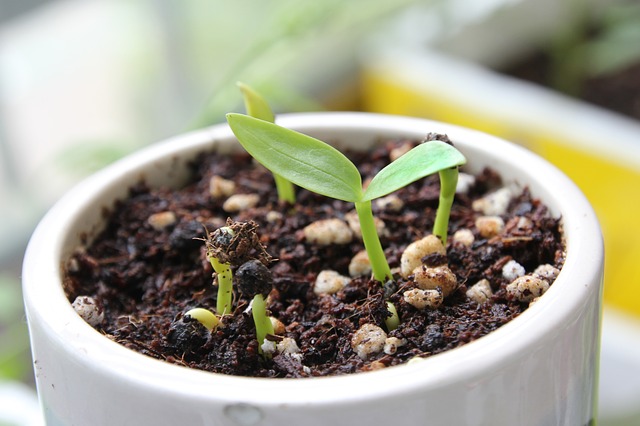Organic gardening is the best way to produce healthy food for your family. All you need is a bit of knowledge. We’ve compiled this simple guide to organic gardening to give you all the resources you need to get started.
- The Scoop on Organic
- Building Organic Soil
- Organic Fertilizers
- Organic Pest Control
- The Dirty Dozen
- The Clean Fifteen
The Scoop on Organic
Back in the 70’s and 80’s organic gardening was something hippies did in communes. It was far from mainstream. Now organic gardening and organic produce have an entirely different reputation. Many consider organic produce a luxury item for well-off folks, while organic gardening itself is considered an expensive, time-consuming and challenging hobby.
Yet there is a growing demand for organic products of all kinds. All around the country people are learning about the damaging effects of pesticides and chemical fertilizers on human health. Mothers don’t want their children exposed to these chemicals, many of which are known toxins and even carcinogens.
There is also a growing interest in the environment. People are starting to think about where their drinking water comes from, and of the effects that farm run-off can have on surrounding ecosystems and even the ocean. This increasing awareness means that lots of people are starting to think about organic gardening at home.
But wait… isn’t organic gardening expensive and, well, hard? It doesn’t have to be. Converting to organic gardening techniques can cost some money to get started, as weakened soils have to be replenished. However, once your organic garden is established, and you are using homemade compost and locally sourced mulch (often free!) in conjunction with sustainable organic gardening techniques, you’ll find that organic gardening is actually saving you money.
RELATED: Why Grow Organic?
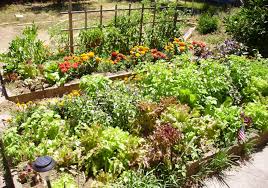
Image courtesy of gardeningottowa.org
Defining Organic
According to our friends at Merriam-Webster, organic means: of, relating to, or derived from living matter.
Let’s consider that definition in terms of organic gardening.
Organic Soil: Think about the rich, crumbly, black earth you might find underneath a thick cover of fallen leaves deep in the forest. This is organic soil at its best. It is the product of decomposed plant matter, slowly broken down and amended by earthworms, bacteria, fungi and other organisms.
Organic Fertilizer: Did you think fertilizer was a no-no in organic gardening? Think again. Organic gardening utilizes fertilizers derived from living things. Think compost tea or spray-on fertilizer brewed from tomato leaves.
Organic Pesticides: A healthy organic garden is naturally resistant to pests. However, even strong plants in great soil are occasionally plagued by insects. Grow organic sprays can be made from things like garlic, peppers and even beer.
Building Organic Soil
The key to success with organic gardening is to build healthy soil. This takes time, as quality organic soil is best built naturally.
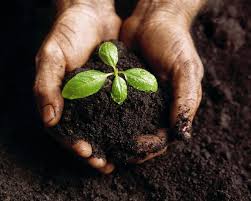
Image courtesy of pelhampubliclibrary.org
If you want to grow organic vegetables easily and cheaply, you need to build organic soil. This means adding organic materials, bit by bit. Most people’s yards and garden beds are full of weak, depleted soil from years of stripping by poor planting practices and overuse of pesticides and fertilizers. Soils are leached and eroded due to conventional practices and need to be replenished by organic gardening.
In addition to being low in essential nutrients, most soils have diminished microbial and fungal populations. Organic gardening has taught us that there is a rich community of microbes in healthy soil which work in conjunction with plants. These organisms take up nutrients like trace minerals that plants can’t utilize on their own, and make them bio-available for plant uptake.
Think about the delicate balance of healthy bacteria in a human digestive tract. To grow organic, plants need the same thing. Using chemical pesticides and fertilizers is like constantly popping antibiotics. It keeps disease at bay, but also damages natural immunity. It will take time and care to rebuild the healthy soil microbes.
Fortunately, even the saddest of soils can be replenished by good organic gardening techniques. Follow these steps to building healthy soil to grow organic vegetables.
1. Test Your Soil
If you haven’t been using organic gardening techniques until now, it is safe to assume that your soil is deficient in one or more nutrients. However, it is hard to say which nutrients are missing. A basic soil test will help you identify the missing elements. The pH of your soil is probably out of balance as well. Finding out if your soil is too acidic or alkaline is important. The pH must be properly balanced if you hope to grow organic vegetables that will be healthy.
Most university agriculture extension offices offer inexpensive soil tests for organic gardening. Check out the school nearest you for more information.
2. Add Amendments
Anything you mix into your soil to improve its quality to grow organic vegetables is an amendment. Once you see the soil test results, you can choose the right additions. For instance, you soil might be too sandy, or have to much clay. The pH may be too acidic to grow organic brassicas like broccoli, kale or cabbage. Or maybe there is a mineral imbalance that will stunt plants.
Here are some common organic gardening amendments:
- Alfalfa Meal – Alfalfa is a legume, and thus a great source of organic gardening nitrogen. Alfalfa pellets also have trace minerals that are necessary to grow organic produce.
- Greensand – This is a natural sand that contains potash, along with iron, silica, magnesium and other trace minerals. Use greensand to loosen heavy clay soils while adding nutrients to grow organic veggies that are strong and healthy.
- Compost – Compost it the best amendment there is and an essential tool for organic gardening. In addition to nutrients it adds healthy microbes and fungi into the soil. It’s like probiotics for your garden.
- Blood Meal – It might sound creepy, but blood meal provides nitrogen at a slow, steady release rate. It is also loaded with trace nutrients and relatively inexpensive.
- Bone Meal – This is basically finally ground bone, which provides calcium and phosphate.
- Chicken Manure – Chicken poop is one of the best manures for organic gardening, because it has the right balance of nutrients. Make sure any manure you add to the garden is well composted or aged. You can even purchase chicken manure in pellets.
- Dolomite Lime – Lime, a classic organic gardening amendment, raises pH in acidic soils and provides calcium and magnesium.
- Coconut Coir – This is simply a fancy name for compressed coconut fibers, and makes an environmentally friendly organic gardening alternative to peat moss.
- Gypsum – Another useful organic gardening tool to loosen heavy clay soils, gypsum is high in calcium and sulfur.
- Kelp Meal – Seaweed provides micro nutrients and molecules that promote healthy plant growth and nutrient uptake. Organic gardening with kelp meal with improve pest resistance in plants.
- Sulfur – Lowers pH in alkaline soils. Add to organic gardening beds that will grow acid-loving plants like blueberries.
- Worm Castings – This is the most nutrient dense compost you can find. Adding worm castings is a quick way to boost both nutrients and organic matter in your soil. Add compost and worm castings to both sandy and clay soils to improve water retention and drainage.
3. Use Lots of Mulch
While amendments provide a quick fix and can help correct major imbalances in soil that has been depleted due to erosion, leaching and farming, in the long run the only way to improve soil in a lasting way is to add organic matter.
It doesn’t matter if you have clay or sandy soils. Add organic matter. Organic matter breaks down into crumbly black soil with lots of humus. It retains plenty of water while allowing drainage during flood conditions. Most importantly, it provides a rich home for the microbes and fungi your plants need to support healthy growth.
Organic gardening is really about soil building. After you build your initial garden bed, which may involve mixing lots of amendments into existing soil, you should focus on building soil from the top down to grow organic produce.
Constant tilling and disruption of the soil damages the delicate networks of fungi and microbes in the soil. You know those white spider-web lines in healthy soil? Those are roadways of healthy fungi that indicate great soil that can grow organic vegetables to win any county fair competition. Tilling breaks those paths, which are very slow to reform.
So how do you build soil for organic gardening from the top down? Just mimic a forest. Add layers of organic material, or mulch, on top of your garden. You can pile six to eight inches of straw, hay (seedless), leaves, grass clippings, wood shavings or any other organic material you can easily get your hands on, all around your vegetables.
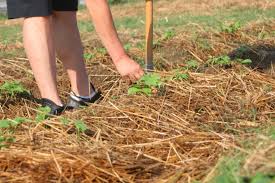
Image courtesy of wjfarm.wordpress.com
The mulch breaks down over time, adding valuable organic matter to the soil. To grow organic successfully you need to get as much value as possible from each item in your garden. Fortunately mulch does many things besides build great soil for organic gardening:
- Reduces Evaporation – Bare soil loses lots of water to the air. Mulch can reduce the amount of water you need to put on your garden by 25-50% simply be limiting evaporation.
- Loosens Soil – After several seasons of heavy mulching, you’ll find that you don’t need to till your soil. Mulch encourages healthy microbial populations in soil, which in turn loosen the soil and render it crumbly and rich. After organic gardening with mulch for awhile, you’ll be able to reach into your garden and dig any necessary holes by hand.
- Stops Soil Compaction – Bare soil is easily compacted, and compacted soil doesn’t let water pass through it, creating dry spots in your garden. Mulch prevents compaction from rain and run-off.
- Stabilizes Soil Moisture – Mulch helps in droughts and flooding rains. It helps the soil retain moisture, while absorbing the extra in times of heavy rain. It helps keep the moisture levels constant.
Jumpstart Your Garden with Lasagna Beds
Looking to build healthy soil quickly? Organic gardening doesn’t have to take years to pay off. Here is an easy, quick way to start a brand new garden bed that is ready for planting immediately and will mature into a healthy organic gardening bed full of rich, crumbly black soil.
Best of all, you don’t have to dig. You don’t even have to remove existing sod, grass or weeds.
You can build a lasagna bed to grow organic vegetables on any existing yard surface.
Here’s what you do:
- Mow Existing Vegetation
- Lay Down Sheets of Cardboard – This acts as a weed mat to prevent existing vegetation from coming into your garden. It also is great earthworm food. If you don’t have cardboard you can lay down three layers of heavy newspaper. Water thoroughly.
- Start Layering! – Anything you can compost can go into a lasagna bed. Alternate brown materials (leaves, coconut coir, twigs, hay, straw) with green materials (grass clippings, kitchen scraps). Use twice as much brown material as green. Build the bed as high as you like. At least 18″ is recommended, though you could go as high as 3-4 feet. Water each layer thoroughly.
- Top with Compost – Cover the last layer with 3-4 inches of aged compost.
It is best to let this lasagna bed sit for at least a month, but you don’t have to. Over time it will shrink considerably. Many people build these beds in the fall for spring planting.
If you want to start organic gardening in a lasagna bed immediately, simply place seeds or transplants directly into the compost on top of the pile.
Back to top
Organic Fertilizers
Even a healthy bed occasionally needs help to grow organic vegetables. Over time, enriched soil will provide all the nutrients your plants need. But at first you will be working with deficient soil.
Until your soil is rich and healthy, you will need to do one of two things to achieve a bountiful harvest:
1. Grow organic plants that don’t require lots of nutrients.
2. Apply organic fertilizers to support heavy feeding plants.
You may choose to use a combination of these two organic gardening strategies.
Light Feeding Plants
There are many nutrients need to grow organic vegetables. Nitrogen, phosphorus and potassium are the big ones, but there are also many micro nutrients and minerals that plants use, like calcium, iron and magnesium.
The plants we like to eat tend to be “heavy feeders”, plants which require a lot of nutrients to grow. Organic gardening favorites like corn, cabbage, broccoli, melons, tomatoes and peppers are heavy feeders.
Fortunately not all tasty vegetables are nutrient hungry. To plan your organic garden well you need to learn about light feeding plants and nutrient accumulators.
Light Feeders – These vegetables take up nutrients but in low quantities. Examples include beets, arugula, carrots, kale, collard greens, chard and parsnips. Grow organic light feeding vegetables in new garden beds or in those that are new to organic gardening techniques.
Other veggies fall between the two, like lettuce, squash, potatoes and zucchini which are medium feeders..
Nutrient accumulators are plants that actually restore nutrients to the soil instead of depleting them. The most well known and easy to grow organic are the legumes, like beans and peas, which restore nitrogen to the soil. There are also many herbs, like cilantro, comfrey and chamomile, which pull up minerals from deep in the soil and bring them to the surface where other plants can use them.
Organic gardening takes good planning. During the first growing season after converting to organic gardening techniques you should try planting light feeding and nutrient accumulating plants. These will help build healthy soil while providing you with a tasty harvest for the dinner table.
Gardening Rotation
You can apply your knowledge of plant feeding types to garden rotations. For instance, this year plant light feeding plants in your garden as you start to build up the soil with mulch and compost. Next year plant nitrogen fixing plants like beans and peas, along with nutrient accumulating herbs. The following season plant heavy feeding plants in the same bed, to clean up the high levels of nitrogen. The fourth year you can go back to light feeding plants, then start the rotation over again.
Ideally you will have several different garden beds set up, each one with a different type of plant growing each season. This is the best way to enjoy a diverse variety of produce while encouraging healthy soil development.
RELATED: 7 Essential Organic Gardening Tips
Organic Fertilizer Recipes
So you switched to organic gardening methods, but you really love corn and can’t wait two or three season to grow it. That’s okay! When all is said and done, the whole point of organic gardening is to grow vegetables that you love to eat.
You can grow organic corn during your first year of organic gardening. You’ll need to use some organic fertilizers. Fortunately they do exist and don’t have to be expensive. Let’s take a look at some easy recipes for organic fertilizers that you can make right at home.
1. Compost Tea – This is a quick pick-me-up for sad looking plants. As you continue to grow organic vegetables, you’ll probably end up starting a compost pile. Before then, you’ll probably purchase compost to boost your soil.
You can use mature compost to make a spray-on fertilizer. Simply place several cups of compost in a bucket and cover with water. Let the tea “brew” for one week, covered in a dark, cool place. Strain the tea, and dilute 1:10 with water. Spray directly on plants once a month, or as often as once a week to grow organic vegetables in weak soil.
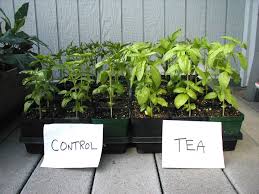
Image courtesy of chesapeaketea.com
2. Immature Compost Tea – If you don’t have access to mature compost, you can still make a rich organic gardening compost tea. Take any fresh green plant material (preferably organic) and fill a 5 gallon bucket with it. This can be trimmings from your garden, wild plants or even grass trimmings, as long as they have no chemicals on them. Weigh the plant material down with a brick or stone. Fill the bucket with water, and let sit for two weeks. Frothy yellow foam will form, and this compost tea will be stinky, but it works wonderfully. After two-four weeks strain the mixture and dilute 1:10 with water. It can be thick and gooey, and will stink, so be prepared.
Do not apply compost tea to any plant full strength. It is strong stuff, with lots of nitrogen that can burn plants if it is undiluted.
3. Coffee Grounds – There’s more to coffee than caffeine. The used grounds are rich in nitrogen and boost plant growth while repelling slugs for an organic gardening double whammy. Sprinkle your old coffee grounds right on top of the soil around the base of your veggies.
4. Egg Shells – Egg shells are rich in calcium, which helps grow strong stems and fight off blossom end rot, an ailment which plagues tomato plants. Let the egg shells dry out, then crush them and add them to a soil mix or apply along with compost on the surface.
5. Organic Calcium Foliar Spray – Get even more out of your egg shells with this spray. Calcium foliar sprays are expensive and often filled with nasty chemicals. This homemade version is simple and healthy, and will promote cell division and healthy flowering. It also provides phosphorus which is essential for plants like tomatoes to produce healthy flowers.
The Recipe: Collect egg shells until you have 1 full cup crushed egg shell. In a dry pan cook half the shells until they begin to blacken. Place all shells, cooked and uncooked, in a large mason jar and fill with water. Cover and place in a dark, cool spot and let sit for one month. Strain and spray directly on plant leaves.
6. Banana Peels – Bananas are rich in potassium, which veggies (and roses!) love. Before planting transplants, toss an organic banana peel or two in the hole. You can also tuck banana peels under mulch to decompose naturally.
7. Seaweed – If you live near the coast seaweed is a free and abundant organic fertilizer. It has lots of trace minerals necessary for healthy plant growth, and actually feeds healthy microbes in the soil. You don’t even have to rinse the salt water off.
How to Prepare Seaweed: Chop 5 cups of fresh seaweed finely, and add to 5 gallons of water. Cover loosely and let sit for 2-3 weeks, then apply to foliage or as a soil drench. You can mix with compost tea fertilizer too.
8. Weed Compost Booster – Those obnoxious weeds growing around your yard and garden are valuable resources if you hope to grow organic. Many of them, like comfrey, nettles, marigolds, dock, and chickweed are mineral accumulators. Applying them to your garden will add those minerals and nutrients into your soil and make organic gardening easy.
Try these applications:
-Chop them up and use around the garden as mulch.
-Add them to your compost pile for a nitrogen and mineral boost.
-Ferment them like an immature compost tea. Don’t forget to dilute the brew.
9. Manure – Manure is the meat and potatoes of organic gardening fertilizers. It is rich in nitrogen and other nutrients. If you don’t have your own animals to produce manure, don’t despair. With a little effort you can easily find a neighbor or local farmer who is more than happy to have you cart away chicken, cow or horse manure free of charge.
Composted or aged manure is best, as fresh has so much nitrogen it can burn plants. If you only have access to fresh manure, apply it to your garden in the fall. Come spring planting the manure will have aged and the garden will be well fertilized and ready to grow organic.
You can also make a manure tea, just like you would brew a compost tea. Again, be sure to dilute the tea before applying to your garden.
10. Worm Castings – Worm castings are the richest form of organic gardening fertilizer you can find. Try starting a worm bin in your house. This is an easy, cheap and odor-free way to begin composting. With a worm bin, you can even produce high quality compost and worm castings for your container veggies while living in an apartment.
DIY Worm Bin
How it Works: Red wiggler worms are the best for breaking down organic materials like food waste into rich compost and worm castings. Simply provide them with a nice home and feed them your table scraps.
What you Need: A plastic tub with a lid. Cardboard and newspaper. Kitchen waste. Red worms.
What to Do: Punch holes in the lid. Line the plastic tub with cardboard and fill 1/3 full of newspaper. Add the red wiggler worms. Toss in kitchen scraps. Allow the worms to consume 2/3 of the scraps before adding more organic waste. If the bin begins to smell you need to wait longer before adding more food. As the bin fills you can remove some of the finished castings for your organic gardening beds or containers.
Organic Fertilizers for Sale
Maybe brewing up compost tea sounds like a lot of work, or maybe you simply don’t have the time, space or the right ingredients.
There are many types of organic fertilizers that you can purchase. They do tend to be expensive, but sometimes the convenience is well worth the cost, especially with organic gardening. Here are a few options that we recommend:
- Jobe’s Organic Fertilizer
- Neptune’s Harvest Organic Fish and Seaweed Blend Fertilizer
- Dr. Earth All Purpose Organic Fertilizer
- Unco Industries Earthworm Castings Organic Fertilizer
Organic Pest Control
You’ve committed to using only organic gardening techniques. Does that mean you have to lose half your crop to pests? Absolutely not!
If you stick with organic gardening you will discover that you have fewer and fewer pest problems each season. As your soil is replenished with essential nutrients, your plants will grow stronger and healthier. Building great soil takes time and patience. In the meantime, you may need a little help to protect your veggies from hungry aphids, slugs, mites and molds. Even in your first year of organic gardening you should be able to harvest healthy produce from your garden without significant losses from pests.
You do this by applying organic gardening pesticide sprays. These sprays are cheap and easy to make at home, and use only ingredients that are natural, healthy and environmentally friendly. Never spray something on your veggies that you wouldn’t eat yourself.
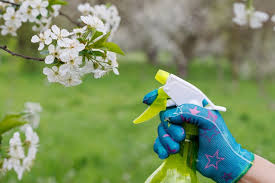
Image courtesy of gbtimes.com
Organic Pest Control Recipes
These recipes for organic gardening pest control really work. And best of all, you probably have ingredients for most of them right in your kitchen or garden.
1. Garlic Oil Spray – Garlic is an essential tool for any organic gardening tool kit. You can plant it around the edges of your garden beds to repel insects. It even keeps rabbits and deer at bay.
To get rid of white flies, aphids and beetles, try applying this spray directly to the plant leaves. Only apply on an overcast day, as the strong oils in garlic can burn leaves in full sunlight.
The Recipe: Place 3-4 cloves of finely minced garlic in 2 teaspoons of mineral oil (olive oil is fine too). Let sit overnight and then strain. Mix oil into one pint of water. Optional: add one teaspoon of biodegradable dish soap to help the spray stick to the leaves.
2. Spicy Pepper Spray – Spicy peppers get their heat from the compound capsaicin. Have you ever cut hot peppers and then touched your eye? It hurts! Insects dislike the feeling as much as we do. Hot pepper sprays are especially effective against white flies and mites. You may need to apply daily for up to a week to kill all the mites.
You can make this spray two ways:
Recipe 1: Mix 2 tablespoons of hot pepper sauce with a few drops of biodegradable dish soap and one quart of water. Let sit overnight and spray directly on infested plants.
Recipe 2: Place 2-3 whole hot peppers (the spicer the better) in the blender with 1 cup of water. Mix thoroughly. Let sit overnight, strain and dilute with one quart of water. Spray on plant leaves.
Be careful when working with really hot peppers. You may need to wear gloves and a mask for blending and straining as capsaicin can damage mucus membranes.
3. Tomato Leaf Spray – There are alkaloids in the leaves of all the nightshade plants (tomatoes, potatoes, peppers and eggplant). These alkaloids are toxic for most insects. Simply shred leaves from any nightshade plant and let them soak in water overnight. Strain and spray directly on affected plants.
4. Beer Slug Trap – Slow moving, slimy and hungry, slugs are an organic gardening nightmare. Many organic gardeners get up in the early morning hours to physically pluck the slugs off their precious plants.
Remember how I said organic gardening doesn’t have to be so hard? Make a beer trap for your slugs instead.
How to do it: Take a pie plate, tuna can or other shallow tin and sink it in the ground so the rim is at ground level. Add beer until their is one inch of open space between the beer and the level of the ground. Slugs are beer crazy! They like the yeast in the beer, and will crawl into the container to drink it. It is important to keep the beer lower than the soil, so the slugs can’t crawl back out.
If you don’t have any beer on hand, try mixing a packet of yeast with water and a bit of sugar or flour and using it the same way.
5. Milk Stops Powdery Mildew – You don’t need toxic fungicides to fight mildew during a wet summer. Just spray milk (whole, reduced fat or skim) on your plants. Apply daily at the first signs of mildew. You will need to reapply several times a week throughout the wet months to prevent new mildew from forming.
6. Baking Soda for Mildew – Here’s another non-toxic, organic gardening recipe to beat back powdery mildew. Mix 1 tablespoon of baking soda with 1 tablespoon vegetable oil, 1 tablespoon biodegradable dish soap and 1 gallon of water. Spray on affected plants once weekly.
The baking soda works by disrupting fungal spores so they can’t germinate and grow.
7. Make Your Own
Try experimenting with ingredients to make your own organic gardening pesticide spray. Here are some ingredients you might try:
- Oil – Use a small amount (1 teaspoon per quart of water) to help the spray stick to the plant foliage.
- Biodegradable Dish Soap – Use like oil to help the spray stick to leaves.
- Garlic and Onions – Insects hate the taste and smell. Great for aphids.
- Marigolds – Marigolds have a compound that repels most pests. A marigold spray makes plants taste like marigolds and pests will leave them alone.
- Hot Peppers – Try any type or combination you have on hand. Mixing peppers with garlic makes a spray that repels even the toughest mites.
- Baking Soda – Use in moderation to combat mildew and other molds.
- Vinegar – Never spray vinegar on your plants. Apply directly to weeds to kill them. Vinegar will burn your plants.
Remember, the best pesticide in organic gardening is healthy soil. Healthy soil grows healthy plants that are naturally resistant to infestation.
Organic Vegetables: The Dirty Dozen
You’ve got the basic tools now to start organic gardening. Building healthy soil is your #1 goal, and you can troubleshoot throughout the season with organic fertilizers and pesticides.
But what organic seeds should you grow organic in your garden? First of all, you should grow vegetables you enjoy eating. Otherwise you simply won’t be excited about your garden.
Growing all the produce your family eats by organic gardening or any other method is time consuming. Most of us have a small organic vegetable patch to supplement our family’s diet, but lack the time to grow all of our own food.
That’s why you need to know about the “Dirty Dozen”. These are the common super market veggies that tend to carry the highest pesticide residues, do the most damage to the environment when they are growing and are generally nasty for your health. Try to fit a few of them into your organic gardening rotation, and buy the rest organic at the grocery store.
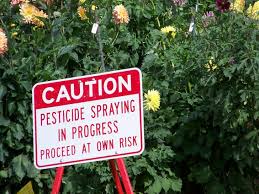
Image courtesy of ladyfreethinker.org
The Dirty Dozen: Vegetables that you should grow organic or buy organic.
- Strawberries
- Apples
- Peaches
- Celery
- Grapes
- Blueberries
- Spinach
- Tomatoes
- Bell Peppers
- Cucumbers
- Lettuce
- Potatoes
Green beans and kale are moving up the list of vegetables with heavy pesticide residues. These are easy to grow organic in most climates, and make a great addition to any organic gardening endeavor.
RELATED: The Easiest Organic Gardening Vegetables to Grow
The Clean Fifteen
There are some fruits and veggies that you don’t have to grow organic. The conventionally farmed ones are actually pretty okay for you and your family to consume.
- Avocado
- Onion
- Grapefruit
- Cabbage
- Kiwi
- Asparagus
- Cauliflower
- Eggplant
- Sweet Corn – Watch for GMO
- Pineapple
- Mango
- Sweet Peas
- Sweet Potatoes
- Honeydew Melon
Get Started Organic Gardening
It is always the right time to grow organic. Start with a small patch, a little vegetable bed or even a few containers. You can grow organic tomatoes or peppers in pots, or start a small organic herb garden. Remember, there is a small investment of money and effort to start, but in the long run organic gardening will save you time and money, while producing amazingly flavorful and healthy food for your family.
It’s easy to grow organic vegetables with compost from your worm bin. Here’s how to get started with red worms.

